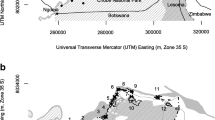Abstract
Context
Animals selectively use landscapes to meet their energetic needs, and trade-offs in habitat use may depend on availability and environmental conditions. For example, habitat selection at high temperatures may favor thermal cover at the cost of reduced foraging efficiency under consistently warm conditions.
Objective
Our objective was to examine habitat selection and space use in distinct populations of moose (Alces alces). Hypothesizing that endotherm fitness is constrained by heat dissipation efficiency, we predicted that southerly populations would exhibit greater selection for thermal cover and reduced selection for foraging habitat.
Methods
We estimated individual step selection functions with shrinkage for 134 adult female moose in Minnesota, USA, and 64 in Ontario, Canada, to assess habitat selection with variation in temperature, time of day, and habitat availability. We averaged model coefficients within each site to quantify selection strength for habitats differing in forage availability and thermal cover.
Results
Moose in Ontario favored deciduous and mixedwood forest, indicating selection for foraging habitat across both diel and temperature. Habitat selection patterns of moose in Minnesota were more dynamic and indicated time- and temperature-dependent trade-offs between use of foraging habitat and thermal cover.
Conclusions
We detected a scale-dependent functional response in habitat selection driven by the trade-off between selection for foraging habitat and thermal cover. Landscape composition and internal state interact to produce complex patterns of space use, and animals exposed to increasingly high temperatures may mitigate fitness losses from reduced foraging efficiency by increasing selection for foraging habitat in sub-prime foraging landscapes.





Similar content being viewed by others
References
Anonymous (2004) Introduction to the Ontario Land Cover data base, second edition (2000): outline of production methodology and description of 27 land cover classes. Spectranalysis Inc., Oakville
Aublet JF, Festa-Bianchet M, Bergero D, Bassano B (2009) Temperature constraints on foraging behaviour of male Alpine ibex (Capra ibex) in summer. Oecologia 159:237–247
Avgar T, Mosser A, Brown GS, Fryxell JM (2013) Environmental and individual drivers of animal movement patterns across a wide geographical gradient. J Anim Ecol 82:96–106
Babyak MA (2004) What you see may not be what you get: a brief, nontechnical introduction to overfitting in regression-type models. Psychosom Med 66:411–421
Belovsky GE (1981) Optimal activity times and habitat choice of moose. Oecologia 48:22–30
Beyer HL, Haydon DT, Morales JM, Frair JL, Hebblewhite M, Mitchell M, Matthiopoulos J (2010) The interpretation of habitat preference metrics under use-availability designs. Philos Trans R Soc Lond B Biol Sci 365:2245–2254
Brown JH, Gillooly JF, Allen AP, Savage VM, West GB (2004) Toward a metabolic theory of ecology. Ecology 85:1771–1789
Burnham KP, Anderson DR (2002) Model selection and multimodel inference: a practical information-theoretic approach, 2nd edn. Springer, New York
Carstensen M, Hildebrand E, Pauly DC, Wright RG, Dexter MH (2014) Determining cause-specific mortality in Minnesota’s northeast moose population. Summaries of Wildlife Research Findings 2013. Minnesota Department of Natural Resources (MNDNR), St. Paul, pp 142–152
Charnov EL (1976) Optimal foraging: the marginal value theorem. Theor Popul Biol 9:129–136
Dahlgren JP (2010) Alternative regression methods are not considered in Murtaugh (2009) or by ecologists in general. Ecol Lett 13:9–11
Fieberg J, Johnson DH (2015) MMI: multimodel inference, or models with management implications? J Wildl Manag 79:708–718
Fieberg J, Matthiopoulos J, Hebblewhite M, Boyce MS, Frair JL (2010) Correlation and studies of habitat selection: problem, red herring or opportunity? Philos Trans R Soc London B 365:2233–2244
Fielding AH, Bell JF (1997) A review of methods for the assessment of prediction errors in conservation presence/absence models. Environ Conserv 24:38–49
Forester JD, Im HK, Rathouz PJ (2009) Accounting for animal movement in estimation of resource selection functions: sampling and data analysis. Ecology 90:3554–3565
Fryxell JM, Hazell M, Börger L, Dalziel BD, Haydon DT, Morales JM, McIntosh T, Rosatte RC (2008) Multiple movement modes by large herbivores at multiple spatiotemporal scales. Proc Natl Acad Sci USA 105:19114–19119
Giudice JH, Fieberg JR, Lenarz MS (2012) Spending degrees of freedom in a poor economy: a case study of building a sightability model for moose in northeastern minnesota. J Wildl Manag 76:75–87
Hammond KA, Diamond J (1997) Maximal sustained energy budgets in humans and animals. Nature 386:457–462
Hanson DS, Hargrave B (1996) Development of a multilevel Ecological Classification System for the state of Minnesota. Environ Monit Assess 39:75–84
Hodson J, Fortin D, LeBlanc ML, Bélanger L (2010) An appraisal of the fitness consequences of forest disturbance for wildlife using habitat selection theory. Oecologia 164:73–86
Hooten MB, Hobbs NT (2015) A guide to Bayesian model selection for ecologists. Ecol Monogr 85:3–28
Illius AW, Albon SD, Pemberton JM, Gordon IJ, Clutton-Brock TH (1995) Selection for foraging efficiency during a population crash in Soay sheep. J Anim Ecol 64:481–492
Jin S, Yang L, Danielson P, Homer C, Fry J, Xian G (2013) A comprehensive change detection method for updating the National Land Cover Database to circa 2011. Remote Sens Environ 132:159–175
Lenarz MS, Fieberg J, Schrage MW, Edwards AJ (2010) Living on the edge: viability of moose in northeastern Minnesota. J Wildl Manag 74:1013–1023
Matthiopoulos J, Hebblewhite M, Aarts G, Fieberg J (2011) Generalized functional responses for species distributions. Ecology 92:583–589
McLoughlin PD, Boyce MS, Coulson T, Clutton-Brock TH (2006) Lifetime reproductive success and density-dependent, multi-variable resource selection. Proc R Soc Lond B 273:1449–1454
McLoughlin PD, Gaillard J-M, Boyce MS, Bonenfant C, Messier F, Duncan P, Delorme D, Van Moorter B, Saïd S, Klein F (2007) Lifetime reproductive success and composition of the home range in a large herbivore. Ecology 88:3192–3201
Mech DL, Fieberg J (2014) Re-evaluating the northeastern Minnesota moose decline and the role of wolves. J Wildl Manag 78:1143–1150
Mitchell MS, Powell RA (2012) Foraging optimally for home ranges. J Mammal 93:917–928
Monteith KL, Klaver RW, Kauffman MJ (2015) Effects of climate and plant phenology on recruitment of moose at the southern extent of their range. Oecologia 178:1137–1148
Murray DL, Cox EW, Ballard WB, Whitlaw HA, Lenarz MS, Custer TW, Barnett T, Fuller TK (2006) Pathogens, nutritional deficiency, and climate influences on a declining moose population. Wildl Monogr 166:1–30
Murray DL, Hussey KF, Finnegan LA, Lowe SJ, Price GN, Benson J, Loveless KM, Middel KR, Mills K, Potter D, Silver A, Fortin M-J, Patterson BR, Wilson PJ (2012) Assessment of the status and viability of a population of moose (Alces alces) at its southern range limit in Ontario. Can J Zool 90:422–434
Mysterud A, Ims RA (1998) Functional responses in habitat use: availability influences relative use in trade-off situations. Ecology 79:1435–1441
Owen-Smith N, Fryxell JM, Merrill EH (2010) Foraging theory upscaled: the behavioural ecology of herbivore movement. Philos Trans R Soc Lond B Biol Sci 365:2267–2278
Peek JM, Urich DL, Mackie RJ (1976) Moose habitat selection and relationships to forest management in northeastern Minnesota. Wildl Monogr 48:3–65
R Core Team (2015) R: a language and environment for statistical computing
Reid S, Tibshirani R (2014) Regularization paths for conditional logistic regression: the clogitL1 package. J Stat Softw 58:1–23
Rempel RS, Rodgers AR (1997) Effects of differential correction on accuracy of a GPS animal location system. J Wildl Manag 61:525–530
Renecker LA, Hudson RJ (1986) Seasonal energy expenditures and thermoregulatory responses of moose. Can J Zool 64:322–327
Ritchie ME (1990) Optimal foraging and fitness in Columbian ground squirrels. Oecologia 82:56–67
Rodgers AR, Rempel RS, Abraham KF (1996) A GPS-based telemetry system. Wildl Soc Bull 24:559–566
Rowe JS (1972) Forest Regions of Canada. Publication 47-1300, Canadian Forest Service, Ottawa, 172 p
Sikes RS, Gannon WL, the Animal Care and Use Committee of the American Society of Mammalogists (2011) Guidelines of the American Society of Mammalogists for the use of wild mammals in research. J Mammal 92:235–253
Speakman JR, Król E (2010) Maximal heat dissipation capacity and hyperthermia risk: neglected key factors in the ecology of endotherms. J Anim Ecol 79:726–746
Stephens PA, Buskirk SW, Hayward GD, Del Rio CM (2005) Information theory and hypothesis testing: a call for pluralism. J Appl Ecol 42:4–12
Street GM, Rodgers AR, Fryxell JM (2015) Mid-day temperature variation influences seasonal habitat selection by moose. J Wildl Manag 79:505–512
Thurfjell H, Ciuti S, Boyce MS (2014) Applications of step-selection functions in ecology and conservation. Mov Ecol 2:1–12
Tibshirani R (1996) Regression selection and shrinkage via the lasso. J R Stat Soc B 58:267–288
Van Beest FM, Van Moorter B, Milner JM (2012) Temperature-mediated habitat use and selection by a heat-sensitive northern ungulate. Anim Behav 84:723–735
Acknowledgments
We thank E.J. Isaac and J. Hagens for arranging data availability. This work was funded by the University of Minnesota-Twin Cities, the Minnesota Department of Natural Resources, the Ontario Ministry of Natural Resources and Forestry, and the Minnesota Environment and Natural Resources Trust Fund.
Author information
Authors and Affiliations
Corresponding author
Electronic supplementary material
Below is the link to the electronic supplementary material.
Rights and permissions
About this article
Cite this article
Street, G.M., Fieberg, J., Rodgers, A.R. et al. Habitat functional response mitigates reduced foraging opportunity: implications for animal fitness and space use. Landscape Ecol 31, 1939–1953 (2016). https://doi.org/10.1007/s10980-016-0372-z
Received:
Accepted:
Published:
Issue Date:
DOI: https://doi.org/10.1007/s10980-016-0372-z




